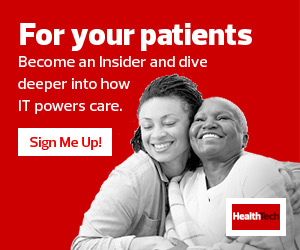From patients’ homes to physicians’ offices and operating rooms, healthcare organizations are using artificial intelligence to support new applications.
Moshe Safran, CEO of RSIP Vision USA, has led the implementation of a wide variety of computer vision products, including an algorithm for 3D reconstruction of heart chambers. Safran recently spoke with HealthTech about the growing potential of AI in healthcare.
HEALTHTECH: What are some of the most widespread AI applications in healthcare right now?
SAFRAN: It crosses many things, from healthcare providers to screening, surgeries, hospital and consumer applications. One of the most widespread applications is in radiology. AI companies are amassing vast amounts of data and saving time for radiologists to ensure experts need to look only at the parts of the scans for which they’re needed. AI can also flag problems that may have gone unnoticed. For example, someone may come in for a CT or orthopedic condition and find a problem that no one was even looking for.
READ MORE: Telehealth leads to positive outcomes in patient behavior.
AI is also used in surgery planning. You can take a CT scan and automatically generate a model of the anatomy for surgery. These surgical planning cases have been around for a while, but AI now makes the algorithms more accurate and robust, with less manual work. Without computer vision, the surgeon can only imagine, but with AI and a 3D model, they can now look at every detail of it to quantify that 3D information.
HEALTHTECH: What other applications might we see in the near future?
SAFRAN: One of the most interesting ones is surgical intelligence, where players develop capabilities that could analyze video and flag issues. It could provide 3D information to the surgeon with safety warnings. These are challenging problems to solve technologically, and there is a lot of potential work being done here under the radar.
Another use would be AI for point-of-care ultrasounds. It could be used by a physician who may not necessarily be an expert in reading those images. There’s an opportunity to train the AI on data collected by experts and improve the interpretation of those images for users who are not experts. Everyone is trying to figure out which capabilities will be possible to bring to market early for the future.
MORE FROM HEALTHTECH: Here’s how digital and omnichannel platforms modernize patient access.
HEALTHTECH: Will AI lead to greater automation of surgery?
SAFRAN: Vehicles already have AI components like lane departure, automatic braking. You’ll eventually have a driverless car. We’re a few years behind that, but surgery is on the same trajectory. There is a wide range of use cases leading in that direction.
HEALTHTECH: What are some best practices for healthcare providers who are thinking about AI?
SAFRAN: The first would be getting the people with the right expertise to the table to talk about how to apply AI. It could be someone from the marketing wing of medical device companies, an opinion leader or someone who can sort of bridge the gap between the technology and the applications.
HEALTHTECH: What key skill sets will healthcare providers need in the future to expand their AI capabilities?
SAFRAN: First, you need technical expertise — like, a deep understanding of the algorithms and technical software proficiency. If you are developing the software, you also need a strong visual intuition of what you are looking for on the images and how to operationalize that with the software. You also need members with a medical perspective to understand how it will work. And you’ll need the business perspective with input from people who will understand how it will create efficiencies and save money.
RELATED: See how technology powers connections between patients and clinicians.












